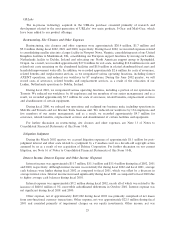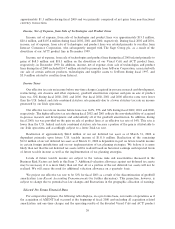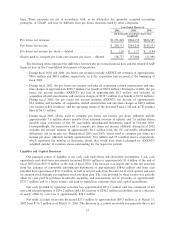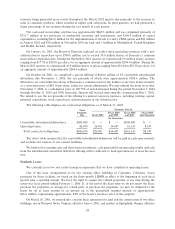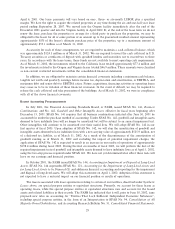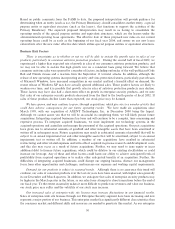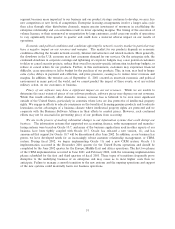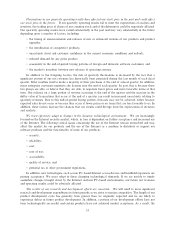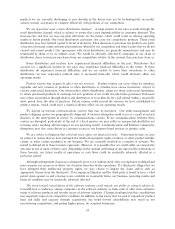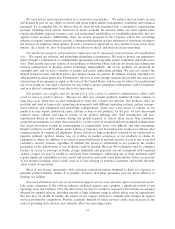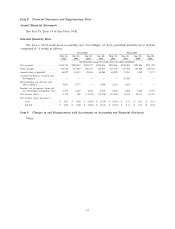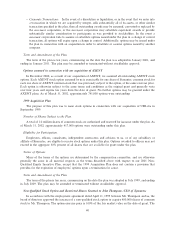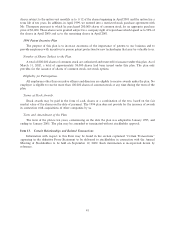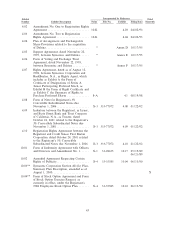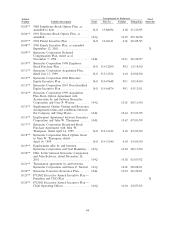Symantec 2002 Annual Report Download - page 56
Download and view the complete annual report
Please find page 56 of the 2002 Symantec annual report below. You can navigate through the pages in the report by either clicking on the pages listed below, or by using the keyword search tool below to find specific information within the annual report.products we are currently developing or may develop in the future may not be technologically successful,
achieve market acceptance or compete eÅectively with products of our competitors.
We are dependent upon certain distribution channels. A large portion of our sales is made through the
retail distribution channel, which is subject to events that cause unpredictability in consumer demand. This
increases the risk that we may not plan eÅectively for the future, which could result in adverse operating
results in future periods. Our retail distribution customers also carry our competitors' products. These retail
distributors may have limited capital to invest in inventory. Their decisions to purchase our products are partly
a function of pricing, terms and special promotions oÅered by our competitors and other factors that we do not
control and cannot predict. Our agreements with retail distributors are generally nonexclusive and may be
terminated by them or by us without cause. We would be adversely aÅected if companies in our chain of
distributors chose to increase purchases from our competition relative to the amount they purchase from us.
Some distributors and resellers have experienced Ñnancial diÇculties in the past. Distributors that
account for a signiÑcant portion of our sales may experience Ñnancial diÇculties in the future. If these
distributors do experience Ñnancial diÇculties and we are unable to move their inventories to other
distributors, we may experience reduced sales or increased write-oÅs, which would adversely aÅect our
operating results.
Product returns may negatively aÅect our net revenues. Product returns can occur when we introduce
upgrades and new versions of products or when distributors or retailers have excess inventories, subject to
various contractual limitations. Our return policy allows distributors, subject to these contractual limitations,
to return purchased products in exchange for new products or for credit towards future purchases. End-users
may return our products through dealers and distributors or to us directly for a full refund within a reasonably
short period from the date of purchase. Future returns could exceed the reserves we have established for
product returns, which could have a material adverse eÅect on our operating results.
We depend on internal communications systems that may be disrupted. Our order management and
product shipping centers are geographically dispersed. A business disruption could occur as a result of natural
disasters or the interruption in service by communications carriers. If our communications between these
centers are disrupted, particularly at the end of a Ñscal quarter, we may suÅer an unexpected shortfall in net
revenues and a resulting adverse impact on our operating results. Communications and Internet connectivity
disruptions may also cause delays in customer access to our Internet-based services or product sales.
We are subject to litigation that could adversely aÅect our Ñnancial results. From time to time, we may
be subject to claims that we have infringed the intellectual property rights of others, or other product liability
claims, or other claims incidental to our business. We are currently involved in a number of lawsuits. We
intend to defend all of these lawsuits vigorously. However, it is possible that we could suÅer an unfavorable
outcome in one or more of these cases. Depending on the amount and timing of any unfavorable resolutions of
these lawsuits, our future results of operations or cash Öows could be materially adversely aÅected in a
particular period.
Although infringement claims may ultimately prove to be without merit, they are expensive to defend and
may consume our resources or divert our attention from day-to-day operations. If a third party alleges that we
have infringed their intellectual property rights, we may choose to litigate the claim and/or seek an
appropriate license from the third party. If we engage in litigation and the third party is found to have a valid
patent claim against us and a license is not available on reasonable terms, our business, operating results and
Ñnancial condition may be materially adversely aÅected.
The trend toward consolidation in the software industry could impede our ability to compete eÅectively.
Consolidation is underway among companies in the software industry as Ñrms seek to oÅer more extensive
suites of software products and broader arrays of software solutions. Changes resulting from this consolidation
may negatively impact our competitive condition. In addition, to the extent that we seek to expand our product
lines and skills and capacity through acquisitions, the trend toward consolidation may result in our
encountering competition, and paying higher prices, for acquired businesses.
34



